Article by Charles Ware and Yi Zhu, PLA, ASLA
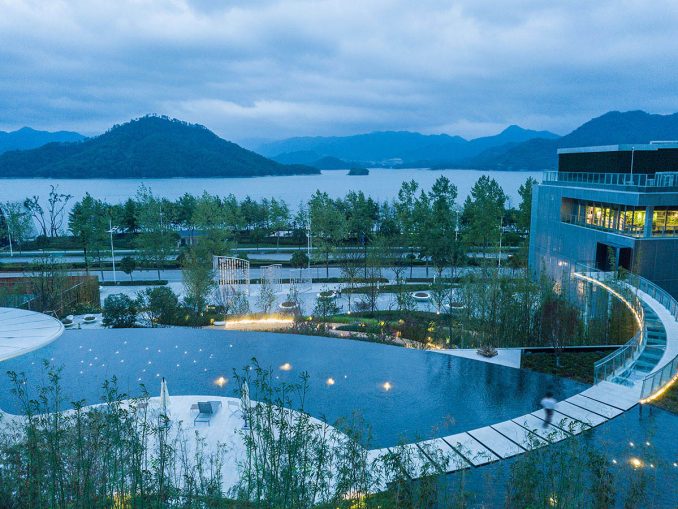
Lakeside Garden, a network of community gathering spaces, offers contemplative venues to relish sublime views across revered Qiandao Lake, with its pristine water, many exotic islands, and lush forested hillsides.
The garden renders relationships among people, nature, and history, using landscape design and art to tell stories of this special place. The lake’s history, including the submersion of villages and cities is part of this story.
Treasured lakeside open space is drawn into the community as a centerpiece. Site planning focuses on the role of commercial and residential uses in framing exterior public spaces. Together with terrain sculpting, a dramatic spatial sequence establishes a picturesque lakeside journey, meandering in a wooded hillside context.
Community access and enlightenment drive the plan, a place for residents to explore and rediscover a majestic landscape, to cherish the unspoiled lake ecology and cultivate a stewardship ethic.
The project fulfills requirements of the Zhejiang Qiandao Lake Water Resources and Ecological Environment Protection Plan. This policy is aimed at improving both landscape management and water resources management.
Site Context
Qiandao Lake occupies a spectacular, densely forested valley on the outskirts of Hangzhou, China. The lake is part of an area known as the Thousand Island Lake Scenic Area, a 448-square kilometer area managed by both ecological and scenic protections. A collection of historic and cultural destinations around the lake complements the natural area. These include villages, temples, bridges, and statues.
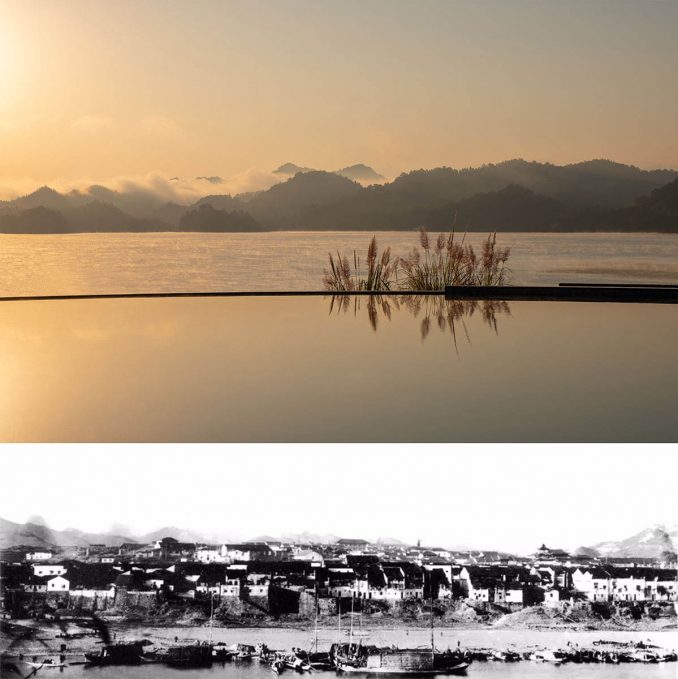
Qiandao Lake rose from the construction of Xin’an River Hydroelectric Dam and ensuing valley flooding in 1959. Dozens of small villages have since settled around this desirable lake. It is a beautiful waterbody known for its clear water, lush islands, ever-changing sky, and forested mountains. The sublime natural beauty, including unpredictable hovering fog and magical light render the site as a living Chinese landscape scroll.
Lakeside Garden is nestled within a 1.0-hectare site, with nine meters of elevation change between the lake and the top of the project site and planned community. Many residents have occupied the area for generations, and they have come to enjoy the lake for its natural beauty. Qiandao Lake also attracts numerous hiking, camping, and cycling visitors, with many drawn to its distinctive beauty.
AN ENLIGHTENING LAKESIDE JOURNEY
Site planning interventions by the landscape architect facilitated the reorganization of building-public relationships to establish the framing, orientation and role of the open space and circulation systems. Programmatic and design strategies establish a dramatic and diverse spatial sequence, orchestrated as abstracted representations of water, forest and sky. Primary design intent focuses on expressing figurative relationships between nature, history, and culture, to bring awareness to these interfaces. By raising community consciousness via both genuine and abstract references, meaning is subject to deliberation and dialogue. River damming, flooding and village resettlement issues are brought to the fore.
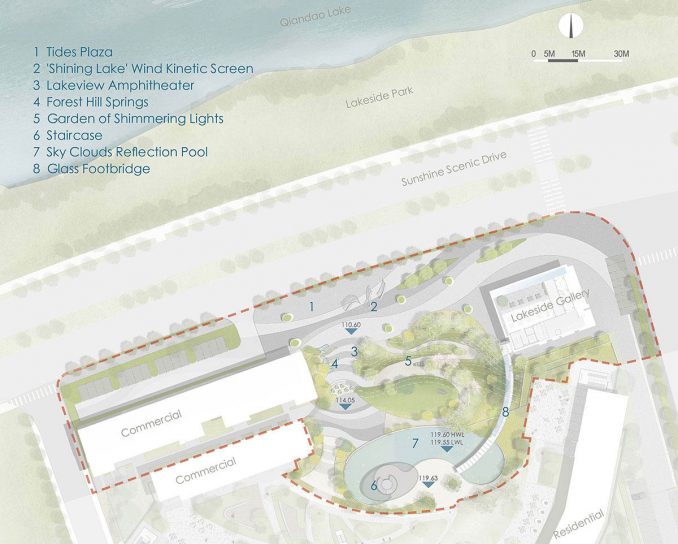
A meandering ascent reveals a series of symbolic gardens, from the lakeside Tides Plaza to the Forest Hill Springs Garden, to the terraced Garden of Shimmering Lights, to the historically- and culturally-inspired space of Silence and Light, and culminating with a magnificent entrance to the Sky Clouds Reflection Pool Plaza. The journey resumes across a glass footbridge to the Lakeside Gallery lobby, where a final panorama is presented.
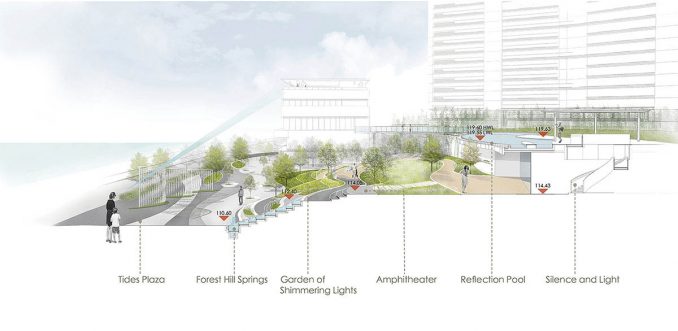
Access to healthy environmental conditions is important in the development of a community-based stewardship ethic. Children immersed in such conditions at an early age are more likely to value ecological and even cultural protections as adults. Such values are likely to be passed on from generation to generation.
Tides Plaza
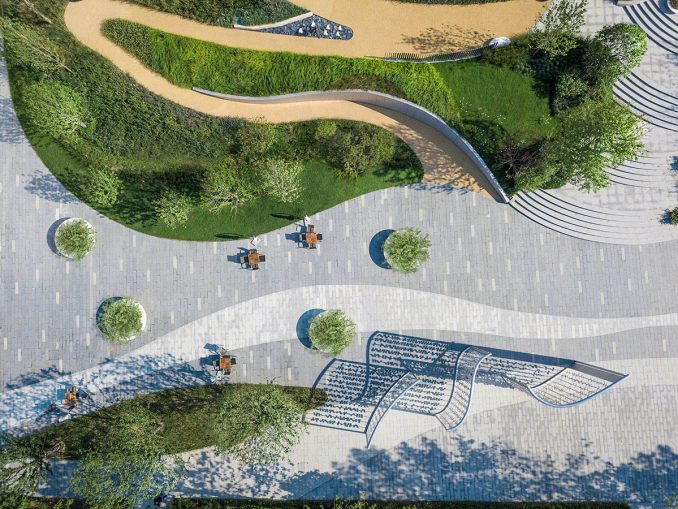
Visitors begin the garden experience from Tides Plaza, a broad but understated space rendered with large-scale ripples. Stone paving patterns, interwoven with black, gray, and speckled white dapples, portray the shimmering lake.
Landscape ribbons intercept and infiltrate rainwater, prior to entering the lake.
A set of wind-animated kinetic screens, known as ‘Shining Lake,’ introduces the context-driven storyline and acts as a welcoming prelude. The screens also serve as a glittering backdrop for informal performances.
Forest Hill Springs
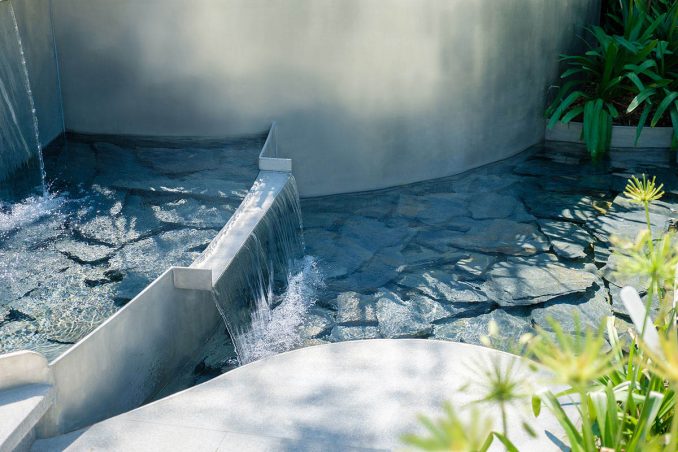
The journey continues, stepping up along ‘spring-fed’ water cascades, abstracting nearby forested hillside streams. Stainless steel cascade architecture subtly reflects plants, sky, and water. Synthetic landscapes are designed to represent and stimulate awareness of natural contextual conditions.
Sweeping monumental stairs simulate mountain terrain, guide access, and provide informal amphitheater seating.
Garden of Shimmering Light
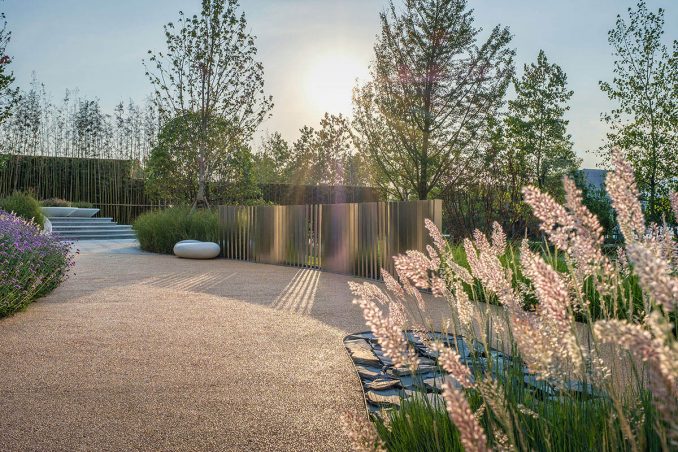
This terrace garden sits in the shadow of a residential tower. Hence, “shimmering light” is conceptualized to amplify indirect light conditions. The garden is appointed with a range of natural and manufactured elements, materials, and surfaces to bolster the effects of subdued ambient light, with subtle shadows and lightly dappled projections. Some elements absorb light, others reflect it, and others allow its passage. A slatted metal panel shimmers. Waving inflorescent grass seed heads glow. Contemporary rock fountains both reflect and absorb light.
‘Rolling Hills,’ a sculptural stainless steel strap bench, irregularly reflects light and establishes a visual connection to the undulating hills that envelope the lake.
Silence and Light
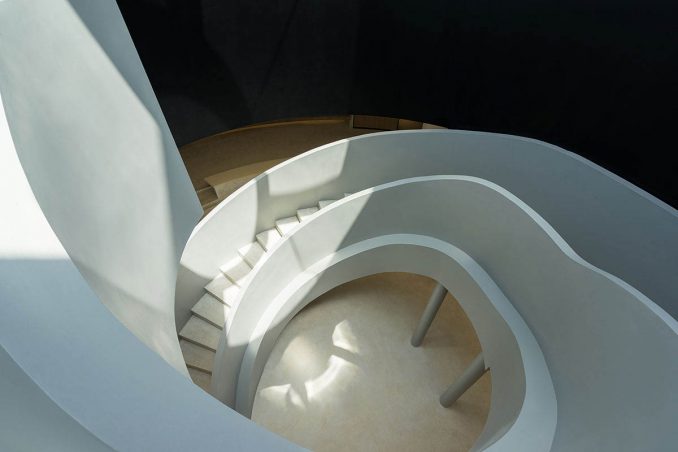
An underground enclosure is dedicated to silence, introspection, and controlled light. The space is wrapped with historic “Underwater Ancient Villages” exhibits from Qiandao Lake. And while the flooding of over 1,000 villages and two cities is controversial, it is shared here so not to be forgotten.
These include a magnificently well-preserved ancient city known as Shi Cheng, which lies at the foot of Wu Shi Mountain, now an island after flooding of the valley. It was built during the Eastern Han Dynasty (AD 25-200). The role of the Lakeside Garden project in remembering historic and cultural conditions is a key component of a broader stewardship ethic.
Light entering the space from above beckons one upward. Climbing a sculptural staircase, the experience gradually reveals the open sky, with best-yet panoramic lake and mountain views.
The sequence is inspired by the classic Chinese fable “The Peach Blossom Spring”: “At first it was extremely narrow, allowing for only one person to squeeze through. After walking another twenty or thirty paces, he suddenly exited onto an open clearing.”
Sky Clouds Reflection Pool
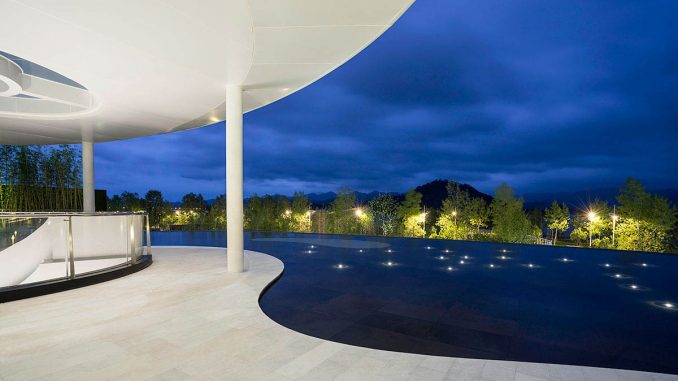
Upon revelatory entrance onto the topmost plaza, a sinuous infinity reflection pool frames and extends the lake and mountain horizon, visually obscuring the street view. The pool is also positioned to frame melded water and sky views, including the reflection of sky and clouds.
The pool water level is designed to fluctuate two inches, symbolizing Qiandao Lake’s seasonal variation. An ‘island’ is set one inch below high-water level, a stage where performers appear to be floating on water. When the water level is low, the ‘island’ is exposed. Pool bottom ‘Starry Sky’ twinkle lights evoke a poetic image of “underwater ancient villages,” reflecting the unique and sentimental history of the former valley.
Glass Footbridge
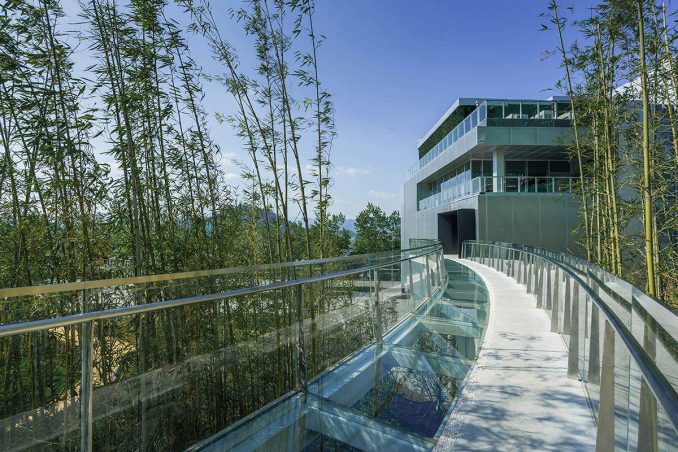
An arcing glass footbridge traverses the reflection pool and sweeps through a whispering bamboo grove. The grove veils distant views, establishing a tranquil and introspective passage before entering the lively Lakeside Gallery.
Lakeside Gallery Lobby
Having sauntered across the glass bridge one arrives in the Lakeside Gallery lobby, where yet another majestic lake panorama is presented. The view frames the shimmering lake, verdant mountains, and temperamental sky. This culminating vantage reminds the community that landscapes and ecosystems can be cherished and enjoyed without adverse impacts to their health.
Lakeside Garden: Tales of People, Place and History
Location: Qiandao Lake, Hangzhou, China
Landscape Architect: TOPOS Landscape Architects
Lead Designer: Yi Zhu, PLA, ASLA
Landscape Contractor: Zhongjing
Art Contractor: Sujing
Conceptual Image Credits: TOPOS Landscape Architects
Photo Credits: TOPOS Landscape Architects (Photographer: Qi Xi)
Text Credit: Charles Ware and Yi Zhu, PLA, ASLA
